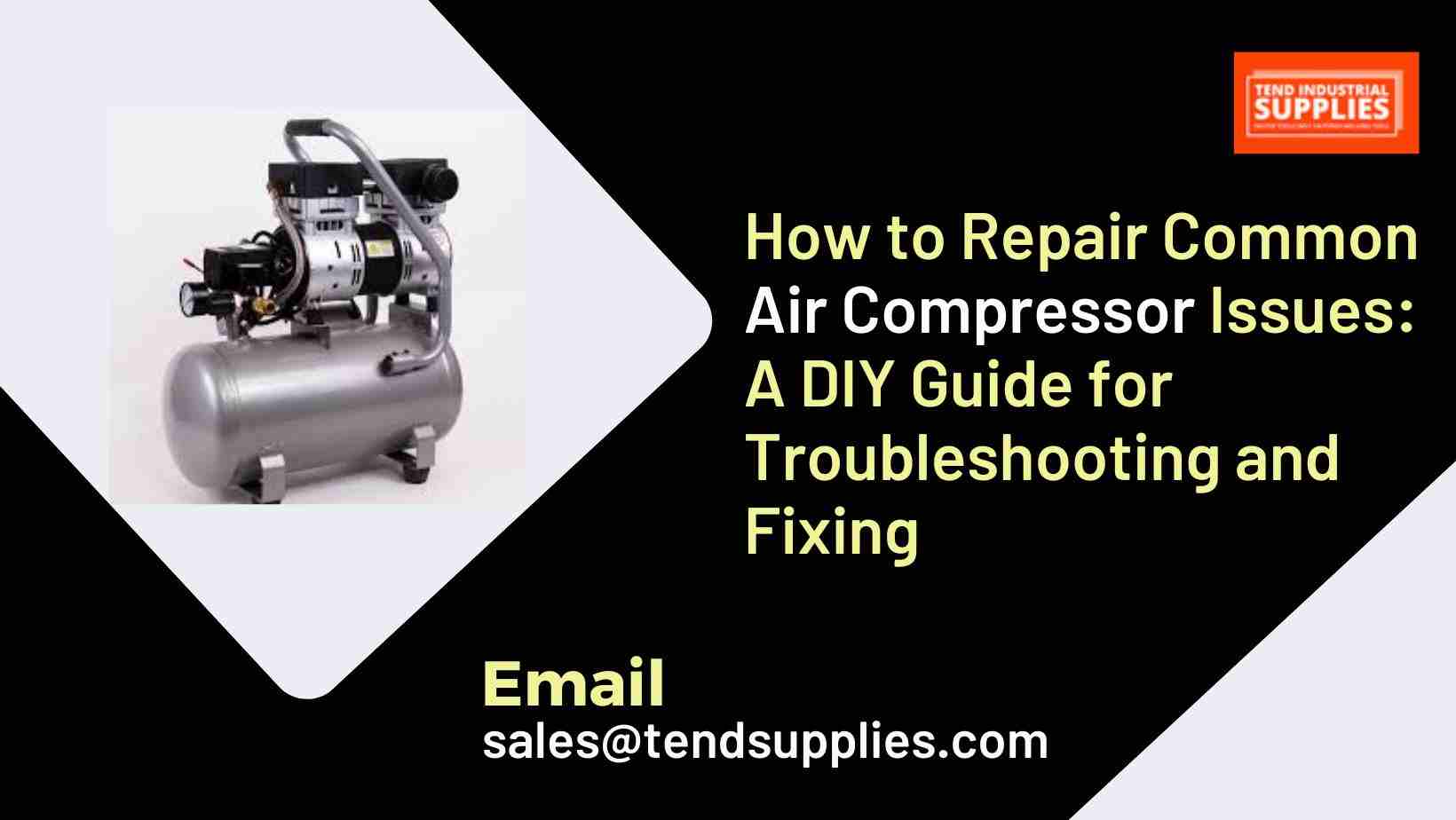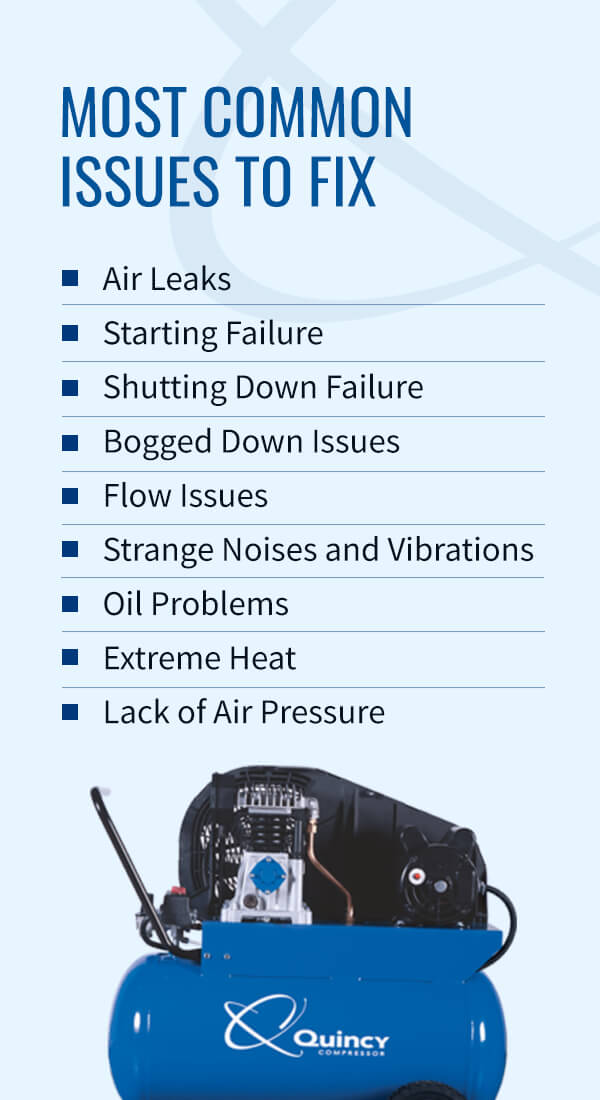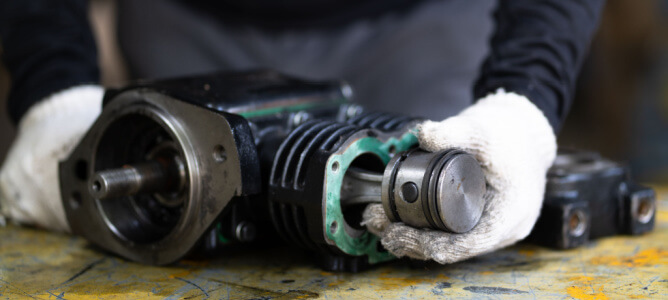To fix common air compressor issues, first identify the problem, then follow targeted repair steps. Proper maintenance ensures longevity and efficiency.
Air compressors are essential tools in various industries and home workshops. They power pneumatic tools, inflate tires, and even assist in HVAC systems. Despite their robust design, air compressors can encounter issues like leaks, pressure drops, or motor failures. Regular maintenance and timely repairs can prevent these problems, saving time and money.
This guide will provide practical solutions to fix common air compressor issues. It will also offer tips on maintaining your compressor for optimal performance. By following these steps, you can ensure your air compressor remains reliable and efficient for years to come.
Air Compressor Won’t Start
Is your air compressor not starting? This can be a frustrating issue. Understanding why your air compressor won’t start can save you time and money. Here, we will guide you through simple checks and fixes.
Power Supply Check
First, ensure the power supply to your air compressor is stable. Check if the power cord is properly plugged into the outlet. Inspect the cord for any visible damage.
Use a multimeter to test the outlet voltage. The outlet should provide the voltage your air compressor requires. Refer to your air compressor manual for the correct voltage.
If the outlet is faulty, try another outlet. If the issue persists, check your circuit breaker. Sometimes, a tripped breaker can stop power flow to the outlet. Reset the breaker and test the outlet again.
| Power Supply Issue | Solution |
|---|---|
| Damaged power cord | Replace the cord |
| Faulty outlet | Use a different outlet |
| Tripped circuit breaker | Reset the breaker |
Pressure Switch Issues
The pressure switch controls the compressor’s start and stop functions. If your air compressor won’t start, the pressure switch might be faulty.
First, ensure the compressor tank is empty. An overfilled tank can prevent the compressor from starting. Drain the tank if needed.
Check the pressure switch for visible signs of wear or damage. Use a multimeter to test the switch continuity. If the switch is not functioning, it might need replacement.
- Empty the tank
- Inspect the pressure switch
- Test switch continuity with a multimeter
- Replace the switch if necessary
These simple checks can often resolve issues with air compressors not starting. Regular maintenance and inspections can help keep your compressor running smoothly.
Low Air Pressure
Air compressors are essential tools for many tasks. Yet, they sometimes face problems. One common issue is low air pressure. This can disrupt your work and cause delays. Let’s explore how to fix it.
Intake Filter Blockage
An intake filter blockage can reduce air pressure. The filter keeps dust and debris out of the compressor. Over time, it can get clogged.
- Turn off the compressor and unplug it.
- Locate the intake filter. It’s usually on the side of the unit.
- Remove the filter and inspect it for dirt.
- If dirty, clean it with soapy water and let it dry.
- If the filter is damaged, replace it with a new one.
Regularly checking the filter can prevent future blockages. Clean or replace it every few months.
Regulator Malfunction
The regulator controls the air pressure coming out of the compressor. A malfunctioning regulator can lead to low air pressure.
- Ensure the compressor is turned off and unplugged.
- Locate the regulator. It’s often near the pressure gauge.
- Check if the regulator is set to the desired pressure.
- If not, adjust it using the control knob.
- If the regulator does not respond, it may need replacement.
Replacing a faulty regulator can restore proper air pressure. Always refer to the manual for specific instructions.
By fixing these common issues, you can maintain optimal air pressure in your compressor. Regular maintenance ensures smooth operation and long life for your equipment.
Overheating Problems
Overheating is a common issue for air compressors. It can lead to severe damage if not addressed. High temperatures can cause wear and tear. Identifying the root cause is essential to prevent further issues. This section will help you with simple solutions.
Ventilation Solutions
Proper ventilation is crucial to keep your air compressor cool. Ensure there is enough space around the unit. Avoid placing it in enclosed or cramped areas. These areas trap heat and cause the unit to overheat.
Use fans to help circulate air. This helps dissipate heat. Install ventilation systems if necessary. It allows hot air to escape. Regularly clean the vents to remove dust and debris. Blocked vents restrict airflow and cause overheating.
| Action | Benefit |
|---|---|
| Ensure open space | Better air circulation |
| Use fans | Reduces heat buildup |
| Clean vents | Prevents blockages |
Oil Levels
Maintaining proper oil levels is vital. Low oil levels can cause overheating. Check the oil levels regularly. Refill it as needed. Use the correct type of oil for your compressor. Refer to the manufacturer’s guide for specifications.
Inspect the oil for contamination. Dirty oil can lead to poor lubrication. This increases friction and heat. Change the oil as per the maintenance schedule. It ensures optimal performance and prevents overheating.
- Check oil levels weekly.
- Use the right oil type.
- Inspect for contamination.
- Change oil regularly.
Keeping an eye on these factors can prevent overheating. It extends the life of your air compressor.
Excessive Noise
Loud air compressors can disrupt your workspace. Identify and fix excessive noise with our detailed air compressor repair guide. Ensure efficient and quieter operation with these expert tips.
Is your air compressor making too much noise? This is a common issue. Excessive noise can indicate various underlying problems. Fixing it promptly can prevent further damage. Below are some possible reasons and solutions for a noisy air compressor.
Loose Parts
Loose parts can cause excessive noise. Inspect all bolts, nuts, and screws. Ensure they are tight and secure. Loose parts can rattle and cause noise. This is a simple fix that can save you from bigger issues.
| Part | Action |
|---|---|
| Bolts | Tighten with a wrench |
| Nuts | Use a spanner |
| Screws | Tighten with a screwdriver |
Bearing Problems
Bearings can wear out over time. Worn bearings can cause grinding noises. Regular maintenance can prevent this issue. Check the bearings for any signs of wear. If worn, replace them immediately.
- Turn off the air compressor.
- Remove the cover to access the bearings.
- Inspect the bearings for wear and tear.
- Replace worn bearings with new ones.
- Reassemble the air compressor.
Pro Tip: Always use high-quality bearings for replacement. This ensures longevity and smooth operation.
Addressing these issues can make your air compressor quieter. Regular maintenance is key to preventing noise and other problems.
Oil Leaks
Oil leaks are a frequent issue with air compressors. They can lead to reduced efficiency and increased wear. Identifying and fixing oil leaks promptly ensures your air compressor runs smoothly.
Seal Inspection
Inspecting seals is crucial for preventing oil leaks. Damaged seals allow oil to escape. Follow these steps for a thorough seal inspection:
- Turn off the air compressor.
- Locate all seals, including those on the pump and motor.
- Check for any visible damage or wear.
- Look for oil stains around the seals.
- Replace damaged seals immediately.
Regular seal inspections ensure your air compressor operates efficiently.
Gasket Replacement
Gaskets play a vital role in preventing oil leaks. Over time, gaskets can wear out or become damaged. Here’s how to replace gaskets:
- Turn off the air compressor and disconnect it from the power source.
- Locate the faulty gasket.
- Remove the old gasket carefully.
- Clean the gasket area to remove any debris or oil.
- Install the new gasket, ensuring a snug fit.
- Reconnect the power and test the air compressor for leaks.
Replacing gaskets prevents oil leaks and extends the life of your air compressor.

Air Leaks
Air leaks are a common issue with air compressors. These leaks can reduce efficiency and increase energy costs. Fixing air leaks promptly can enhance the performance of your air compressor.
Hose Inspection
Inspecting the hose is the first step in identifying air leaks. Check the entire length of the hose for any visible damage. Look for cracks, holes, or worn-out sections. If you find any damage, replace the hose immediately.
Use a soapy water solution to detect smaller leaks. Apply the solution along the hose and watch for bubbles. Bubbles indicate a leak. Mark the spots with bubbles for repair or replacement.
Fitting Tightening
Loose fittings can also cause air leaks. Regularly check all fittings and connections. Use a wrench to tighten any loose fittings. Be careful not to over-tighten, as this can cause damage.
Use Teflon tape for a more secure seal. Wrap the tape around the threads of the fittings before tightening. This will help prevent future leaks.
| Step | Action |
|---|---|
| 1 | Inspect the hose for damage |
| 2 | Use soapy water to detect leaks |
| 3 | Mark the leak spots |
| 4 | Check and tighten fittings |
| 5 | Use Teflon tape for better sealing |
Regular Maintenance tips
Regular maintenance of your air compressor ensures its longevity and efficiency. Neglecting basic care can lead to unexpected breakdowns and costly repairs. Here are some essential tips to keep your air compressor running smoothly.
Routine Inspections
Conducting routine inspections helps identify potential issues before they escalate. Follow these steps for a thorough check:
- Check for leaks: Inspect hoses and connections for any air leaks.
- Monitor oil levels: Ensure the oil level is adequate and clean.
- Inspect air filters: Clean or replace dirty filters to maintain airflow.
- Examine belts: Look for signs of wear and replace if necessary.
Replacement Schedules
Adhering to a replacement schedule prevents unexpected failures. Here’s a basic guideline:
| Component | Replacement Frequency |
|---|---|
| Air Filter | Every 3 months |
| Oil | Every 500 hours of use |
| Belts | Every 1 year |
| Hoses | Every 2 years |
Following these tips can save you time and money in the long run. Regular checks and timely replacements keep your air compressor in top shape.


Frequently Asked Questions
How To Fix An Air Compressor That Won’t Start?
First, check the power source and ensure it’s plugged in. Inspect the fuse or circuit breaker. Test the pressure switch and reset it if needed. Ensure the motor is not overheating.
Why Is My Air Compressor Making Noise?
Excessive noise can be due to loose components or worn-out parts. Tighten all screws and bolts. Check for damaged bearings or belts. Regular maintenance helps prevent noise issues.
What Causes Air Compressor Leaks?
Leaks often stem from loose fittings or damaged hoses. Inspect all connections and tighten them. Replace any cracked or worn-out hoses. Regularly check for leaks to maintain efficiency.
How To Maintain Air Compressor Filters?
Clean the filters regularly to ensure optimal performance. Replace them if they are damaged or overly dirty. Regular maintenance extends the lifespan of your compressor.
Conclusion
Fixing common air compressor issues can save time and money. Regular maintenance ensures longevity and optimal performance. Follow the guide to address typical problems effectively. Remember to consult a professional for complex repairs. Keep your air compressor running smoothly by staying proactive with its upkeep.
Happy repairing!

